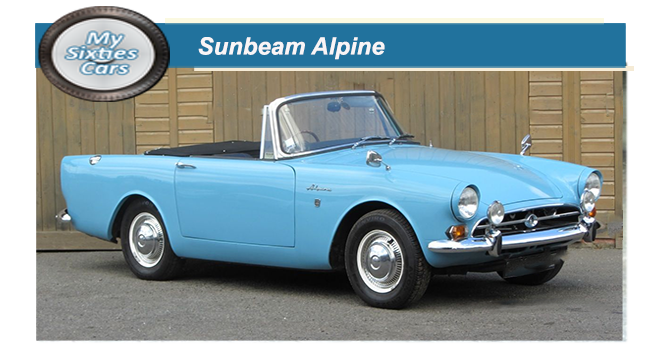
During the late Fifties, Sunbeam decided that the time was right to get back into the open top roadster market, where they had enjoyed a lot of success during the pre-war years.
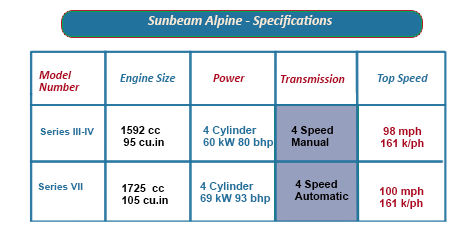 Their first attempt, the Alpine Mark I, while well received, had a negative reputation from its bulky appearance and was certainly dated in design.
Their first attempt, the Alpine Mark I, while well received, had a negative reputation from its bulky appearance and was certainly dated in design.
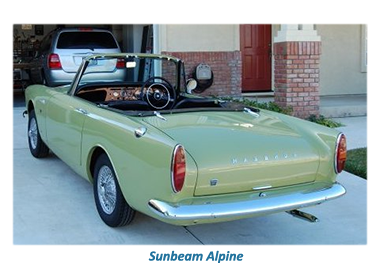 That was why Sunbeam wasted little time in replacing the model with a Mark II version,which they launched in October of 1960.
That was why Sunbeam wasted little time in replacing the model with a Mark II version,which they launched in October of 1960.
The launch proved to be a brave yet wise move as the Sunbeam Alpine Series II went on to become one of the more iconic and commercially popular open tops of the Sixties.
The Mark II Alpine was typical of the Rootes's resourceful product planning, in which they drew the best parts from their already wide range of vehicles in current productions,
Typical of previous Sunbeam models, which were generally better equipped than their rivals, the Alpine boasted such luxurious features as hand winding windows and a proper heater.
Sunbeam’s soft top was also looked upon as being “ softer and more civilised “than most of its rivals.
The Alpine Mark II and the subsequent models in the range were built on a short-wheelbase version on the Minx/Rapier platform (actually coming from the Husky estate car!), while the 1592cc (97 cu in) engine and transmission was a more powerful version of that used on the Rapier.
![]()
With the Mark II version of the Sunbeam Alpine, the Rootes Group’s design team really hit the nail on the head, creating a smart looking two-door sports body which stood out for its prominent fins.
A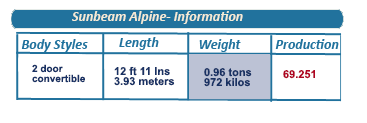 nother plus, especially for UK owners, was that the Alpine’s soft top was attached to the body and did not have to be fished out of the boot when the weather turned inclement.
nother plus, especially for UK owners, was that the Alpine’s soft top was attached to the body and did not have to be fished out of the boot when the weather turned inclement.
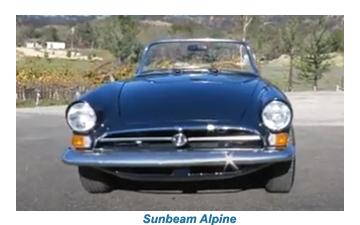 Instead when the Alpine’s soft-top, when furled, could be neatly concealed under fold-back steel cover panels behind the seats.
Instead when the Alpine’s soft-top, when furled, could be neatly concealed under fold-back steel cover panels behind the seats.
 A lift-off aluminium hardtop was available as an optional extra, for those who could do without the need for wind rolling through their hair.
A lift-off aluminium hardtop was available as an optional extra, for those who could do without the need for wind rolling through their hair.
Throughout the Sixties, Sunbeam continued to update the Alpine, mostly cosmetically with little changes being made technically.
Also for the Series III, twin fuel tanks replaced the single item fitted to earlier cars, considerably increasing the size of the baggage area.
![]()
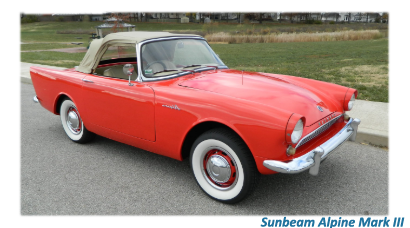 The Series IV was launched in January 1964 to subdued fanfare.
The Series IV was launched in January 1964 to subdued fanfare.
Design changes were once again the order of the day, as the model had lost most of its tailfins while the grille had become a single chrome bar in place of the previous four-bar unit.
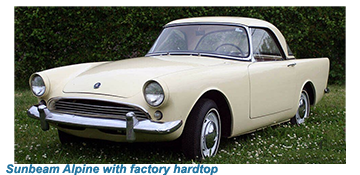 In October of 1964,in an attempt to improve performance and sales, the Mark IV Alpine began to be fitted with an all synchromesh gearbox as standard.
In October of 1964,in an attempt to improve performance and sales, the Mark IV Alpine began to be fitted with an all synchromesh gearbox as standard.
The final version of the Sunbeam Alpine series, the V was introduced in October 1965, and this time there were changes aplenty.
To begin with, the Alpine Series V, came fitted with a more powerful five-bearing engine for the first time.
To increase performance further, the 1724cc (105 cu in) engine was aided by a pair of Stromberg carburettors capable of generating 92bhp, enough to push it the car above the 100mph (161 km/h) barrier for the first time in its history.
This version of the Alpine would turn out to be Sunbeam’s most successful, remaining in production for more than three years.
It was also to be the last of the traditional soft top roadsters , as the Alpine was discontinued in January 1969, to be rapidly replaced by a totally revamped design, produced as a hardtop only for the Seventies.





